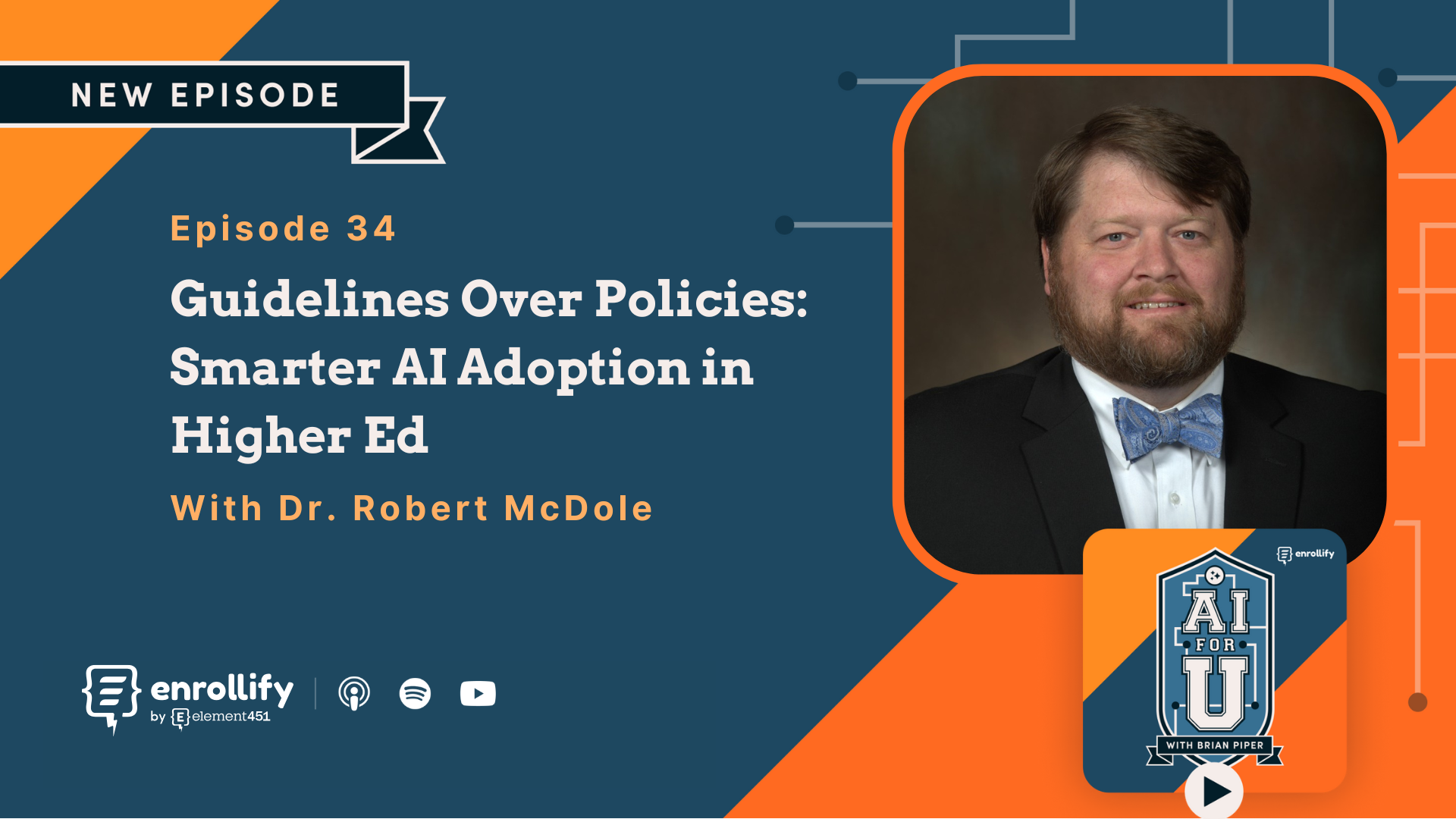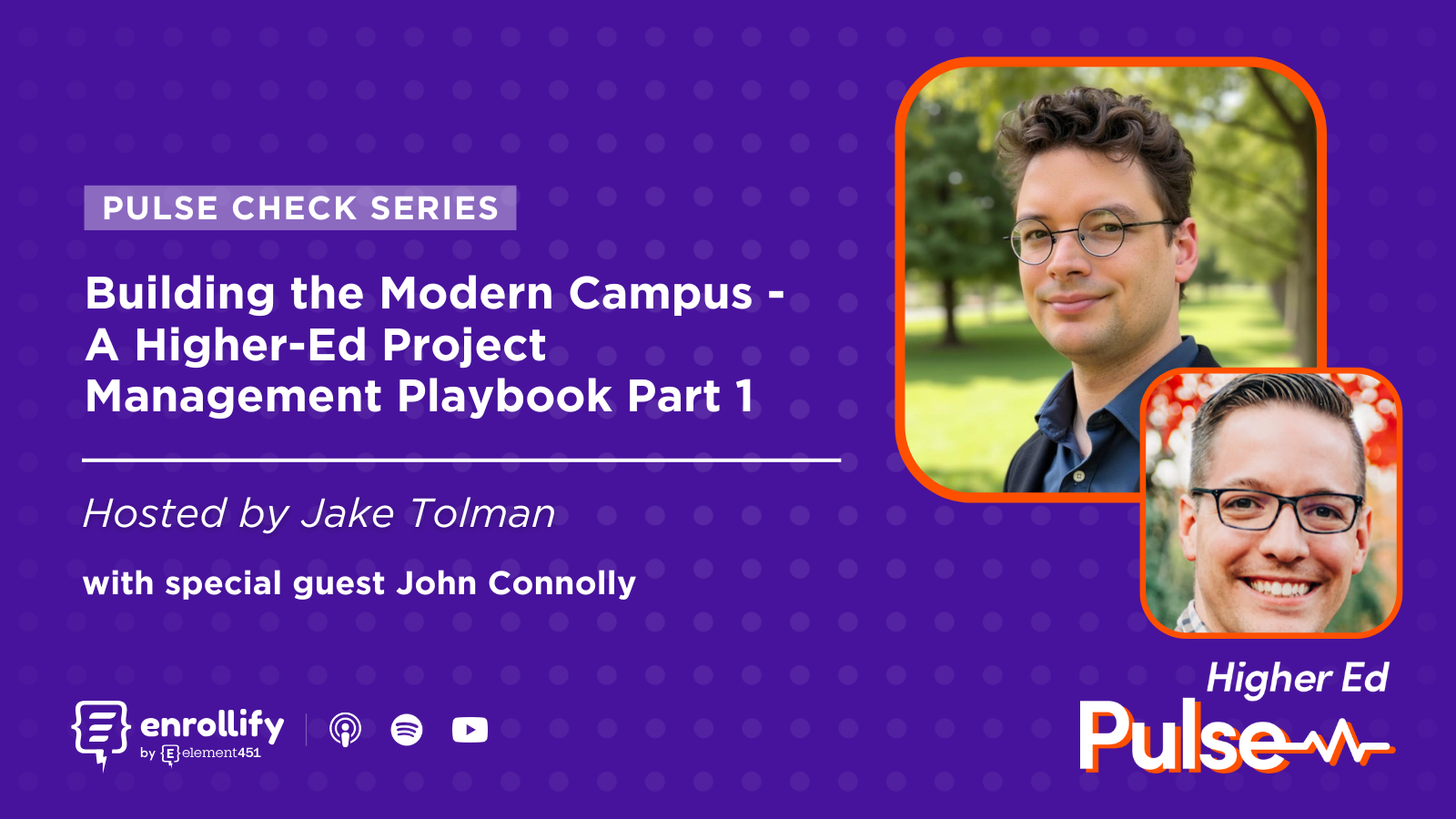About the Episode
Welcome to our latest Pulse Check - A Guide to Graduate Marketing in 2024, hosted by Shane Baglini.
In the final episode of this special series, Shane Baglini is joined by four of the industry's most passionate graduate professionals to discuss all things GEM. This episode provides insights from a director of graduate admissions, a 15-year GEM pro turned agency strategist, a graduate marketing pro and a view from the cabinet as we discuss post-COVID graduate marketing and enrollment, current trends, marketing to graduate students and how graduate enrollment is supplementing the undergraduate enrollment cliff.
Key Insights for Graduate Enrollment Success
1. Meet Students Where They Are
Today’s graduate students demand more flexibility in how, when, and where they learn. Institutions must adopt strategies like stackable certificates, hybrid learning models, and personalized degree pathways to meet these demands and stay competitive.
2. Create Authentic and Transparent Marketing
Authenticity is critical in graduate enrollment marketing. Students want transparency about outcomes, costs, and career paths. Institutions must ensure their marketing matches the on-campus or online experience and provides value-driven content to engage students throughout the funnel.
3. Focus on Community Building
Zoom fatigue and the lack of community in online programs remain key pain points for graduate students. Institutions need to prioritize intentional community-building efforts, both online and in person, to foster a sense of belonging and support.
4. Invest in Digital Tools and Personalization
The rise of stealth applicants means institutions must embrace digital tools like CRMs, AI-driven chatbots, and robust analytics platforms. These tools enable personalized engagement at scale, ensuring prospective students receive the right messages at the right time.
5. Innovate or Fall Behind
Graduate enrollment professionals must embrace a business-minded approach to succeed in an increasingly competitive market. From program-level marketing to adopting AI tools and evaluating the ROI of programs, innovation is no longer optional—it’s a survival strategy.
How Have Student Expectations Changed Post-COVID?
The panel reflected on how the pandemic reshaped graduate students' priorities and expectations. Students are increasingly seeking flexibility in course delivery, whether it’s hybrid, in-person, or stackable programs. However, many are fatigued by fully online experiences and crave community and connection. Institutions must strike a balance between convenience and interpersonal engagement.
What Are the Key Challenges Facing Graduate Enrollment Professionals?
- Zoom Fatigue and the Loss of Community: Graduate students feel disconnected in fully online programs, leading to lower engagement. Institutions must intentionally design online and hybrid formats to foster interaction.
- Stealth Applicants: Students are increasingly applying without prior engagement, conducting their own research online. This trend forces schools to make their websites and digital resources more comprehensive and value-driven.
- Market Pressures and Program Viability: Declining demand for certain graduate programs and competition from alternative credential providers like Coursera are driving institutions to evaluate and sunset underperforming programs.
How Can Institutions Adapt to Evolving Graduate Markets?
The conversation highlighted several actionable strategies:
- Double Down on Value: Provide transparent ROI data about programs, including career outcomes and salary growth.
- Embrace Program Innovation: Offer stackable certificates and micro-credentials that can lead into master’s programs, meeting students where they are academically and financially.
- Invest in Digital Marketing: Use tools like Element451 to personalize outreach and nurture stealth applicants. Build marketing campaigns that guide students through every step of the decision-making process.
- Rethink Graduate Leadership: Schools like Boston College are investing in centralized, graduate-focused roles to serve as internal consultants, providing expertise to decentralized programs and ensuring alignment with institutional goals.
What Are the Big Trends to Watch Over the Next 3-5 Years?
The panel shared predictions for the future of graduate enrollment:
- Proliferation of AI Tools: From chatbots to predictive analytics, AI will transform how institutions engage with students and market their programs. Schools must ensure their websites and marketing materials are optimized for AI-driven searches and recommendations.
- Focus on Innovation: Institutions must innovate program delivery, marketing strategies, and student services to remain competitive in a crowded market. Schools that fail to adapt risk losing students to more flexible, affordable options.
- Rise of Stackable Credentials: Expect more institutions to embrace stackable certificates and micro-credentials as a way to attract working professionals and allow them to upskill on their own time.
- Data-Driven Decision Making: Enrollment teams will increasingly use analytics to assess program performance, allocate resources, and refine marketing strategies.
Guests:
Kittie Pain, Director of Graduate Admissions, Kutztown University
Marcus Hanscom, Director of Enrollment Marketing, DD Agency
Brett DiMarzo, Director, Graduate Enrollment Digital Strategy, Boston College
Keith Ramsdell, Vice President for Enrollment Management and Marketing, Ashland University















